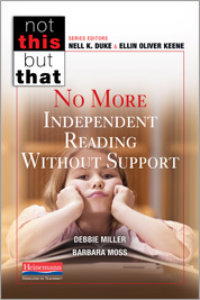Independent Reading Can Boost Learning
No More Independent Reading Without Support
By Debbie Miller and Barbara Moss
(Heinemann, 2013 – Learn more)

Would you like to read short books that promote effective, research-based teaching practices by contrasting them with popular but ineffective practices?
Well, Heinemann has begun publishing just such a series – Not This But That – edited by Nell K. Duke and Ellin Oliver Keene. And if No More Independent Reading Without Support is an example of the quality of this series, then I have some new titles to purchase!

Beyond silent reading
This 87-page book, authored by Debbie Miller and Barbara Moss, includes more than 10 pages of references and is divided into three sections. In the first section – Not This – long-time classroom teacher Miller makes a case for using classroom independent reading time as an opportunity to teach students one-on-one.
A common but ineffective practice is to give students 10 minutes of silent reading while the teacher either reads silently or completes administrative tasks. In the worse case scenario, teachers interrupt the class during the reading time to ask questions about particular assignments or other unimportant issues.
Instead, Miller argues, we should be engaging with students about their reading. In order to do this, we need to figure out what classroom activities can be eliminated from our busy day. Otherwise we may miss key teaching moments to support students’ reading progress.
Strategies supported by research
The book’s second section, written by Barbara Moss, co-author of Creating Lifelong Readers Through Independent Reading (IRA 2010), describes research that supports independent reading with instruction.
Research is a two-edged sword; it can guide our instructional practices but it can also be used to regulate our teaching. Therefore, it is imperative that teachers understand research in general and, in this case, what the research says about independent reading. In this section, Moss distills the research about independent reading and describes strategies that support student learning based on the research.
It is worth noting that research published after the 2000 National Reading Panel report, which found no experimental studies to support independent reading in the classroom, does support making classroom time for independent reading as long as certain conditions are met. Based on these later studies, Moss cites the following conditions that must be in place in order for students to progress as readers. According to Moss (16), students need:
• classroom time to read;
• to choose what they read;
• explicit instruction about what, why, and how readers read;
• to read a lot:
• a large number of books and variety of texts;
• access to texts;
• teacher monitoring, assessment, and support during IR; and
• to talk about what they read.
Moss goes on to detail a number of research studies that promote these conditions with effective practices for supporting student growth as readers.
Implementing these strategies
In section three, Miller takes the research back to the classroom and shows how to take advantage of independent reading for teaching purposes. Her “Guiding Principles for Instruction” (47) are simple but thoughtful:
(1) Purpose – What are students working towards?
(2) Authenticity – Does the work that students are doing happen in the world outside the classroom?
(3) Choice – Do students have choices about the work that they’re doing?
(4) Explicit Instruction – How will I show students what I want them to practice?
By following these principles, we can create the necessary classroom conditions to support students during independent reading time.
Miller then describes 10 tactics to make independent reading as effective as possible, as well as a variety of strategies that teachers can use to take advantage of the independent reading time in the classroom.
User-friendly book design
As an added perk, each section contains numerous inserts that point the reader to other parts in the book that detail research or classroom practices related to particular arguments being made. The references section is extensive and teachers can go straight to the source for further reading.
The more informed we are as professionals, the easier and more effective it will be to make claims for effective practices in the classroom, regardless of the bad rap these same practices may be getting at the moment.
No More Independent Reading Without Support is a great choice for a grade level team or school-wide faculty book study. This gem of a book not only informs us about an important educational issue, but it also gives ideas for how this information can be used to improve and enhance classroom practice and student learning.
Elisa Waingort has been teaching in bilingual settings for more than 25 years in public and international schools in North and South America. She is currently teaching ESL in middle school at Academia Cotopaxi, an American International School in Quito, Ecuador. Elisa blogs at A Teacher’s Ruminations and is a member of Cooperative Catalyst. She is also a member of the Elementary Section Steering Committee of the National Council of Teachers of English and serves on NCTE’s Executive Committee. She’s also uncovering Twitter’s power @elisaw5.

































